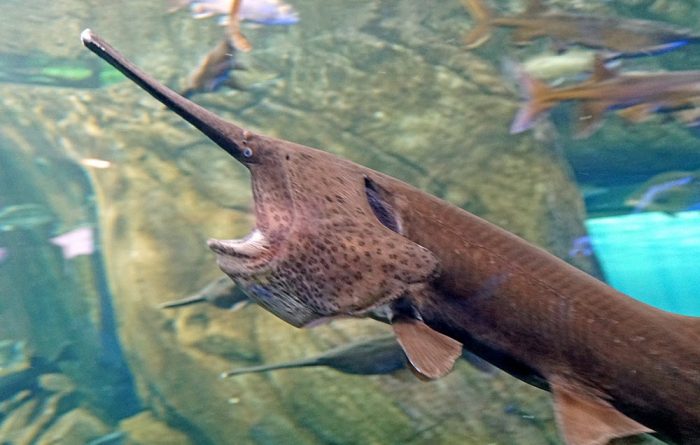Paddlefish, also known as spoonbill catfish, are part of the Polyodontidae family and are known for their distinctive, elongated snouts. Often mistaken for prehistoric relics, paddlefish demonstrate some of the most unusual adaptive qualities in the aquatic world, making them a fascinating species and subject of study.
Historically, paddlefish have been economically valuable for their roe (fish eggs), which were consumed as substitute caviar.

Species
The family includes five genera that were extinct a long time ago (and are known only from fossils), one genus that were extinct more recently, and one extant genus to which all the currently living species belong.
Out of the eight known species, six are only known from fossils. Five of them have been found in North America and one in China.
The more recently extinct species is the Chinese paddlefish (Psephurus gladius) which was last sighted in 2003, in China´s Yangtze River Basin. It was declared extinct in 2022.
The only now living paddlefish is the American paddlefish (Polyodon spathula), which is native to the Mississippi River basin in the United States.
Characteristics
Paddlefish are riverine fish, preferring large, slow-moving bodies of water. Their unmistakable characteristic is their rostrum or paddle – a long, flat extension resembling the blade of a canoe paddle. This rostrum isn’t for feeding or digging but is a super-sensitive organ packed with tens of thousands of sensory receptors. It aids in navigation and locating plankton, their primary food source.
They have large mouths and lack teeth in their elongated jaws. At maturity, paddlefish can become very large and heavy, with the majority of their bulk being muscle rather than fatty tissue.
Paddlefish are primarily filter feeders, subsuming large quantities of water and filtering out zooplankton, their principal diet. Their gill rakers, intricately designed net-like formations within their gills, aid this process.
Migration and reproduction
Paddlefish are migratory, with patterns heavily influenced by water temperature and river conditions. During spawning season (late spring – early summer), paddlefish migrate upstream where females release eggs and males disperse their sperm. They are so-called broadcast spawners, also known as synchronous spawners or mass spawners. Females and males will release their eggs and sperm, respectively, at the same time, and fertilization occurs externally. The eggs are sticky and will adhere to the gravel substrate below. After hatching, the juvenile paddlefish will be swept downstream by the current and reach deep freshwater pools, where they grow into adults.
Paddlefish are long-lived and do not reach sexual maturity until they are quite old. Females will typically not spawn for the first time until they are 6-12 years old, and some individuals will not spawn until they are 16-18 years old. Males will usually start spawning around 4-7 years of age, but some do not until they are 9-10 years old.
Research suggest that it is normal for female paddlefish to only spawn every 2-3 years. Males spawn every year or every other year, if conditions allow.
For spawning to be triggered and take place, several different factors need to be present, including the right water flow, temperature, and photoperiod. The fish must also be able to reach an environment with a suitable gravel substrate. They prefer silt-free gravel bars that have recently been flooded and would otherwise be exposed to air. Therefor, enviroments that are flooded by snowmelt and annual spring rains are important for this fish.
Conservation status
Habitat disruption, overfishing, and pollution have significantly reduced the paddlefish populations. These fish are slow-growing and late-maturing, which makes it extra difficult for them to handle these challenges.
These ancient fish are considered ecological indicators, and their population decline tends to mirror poor water quality and habitat degradation, signalling more significant environmental disruptions which could adversely affect other species in the ecosystem.
Environmental authorities and research organizations are putting efforts in place to maintain and potentially increase the paddlefish populations. Initiatives include modifying dam operations, preserving river habitats, stringent fishing regulations, and hatchery programs.
Paddlefish are listed as “Vulnerable” on the International Union for Conservation of Nature (IUCN) Red List. In the U.S., the American paddlefish is specifically considered by several states as a Species of Greatest Conservation Need, underlining the need for comprehensive management and protective measures.
Background
Paddlefish are sometimes called “primitive fish”, because the Acipenseriformes are among the earliest diverging lineages of ray-finned fish. They diverged from the other groups over 300 million years ago.
Conclusion
Appreciating the paddlefish goes beyond their unique physical traits to their ecological role in our waterways and their potential as an environmental indicator species. As we strive to understand these intriguing creatures better, it is vital that conservation efforts continue to ensure that paddlefish continue to inhabit our rivers for generations to come.
